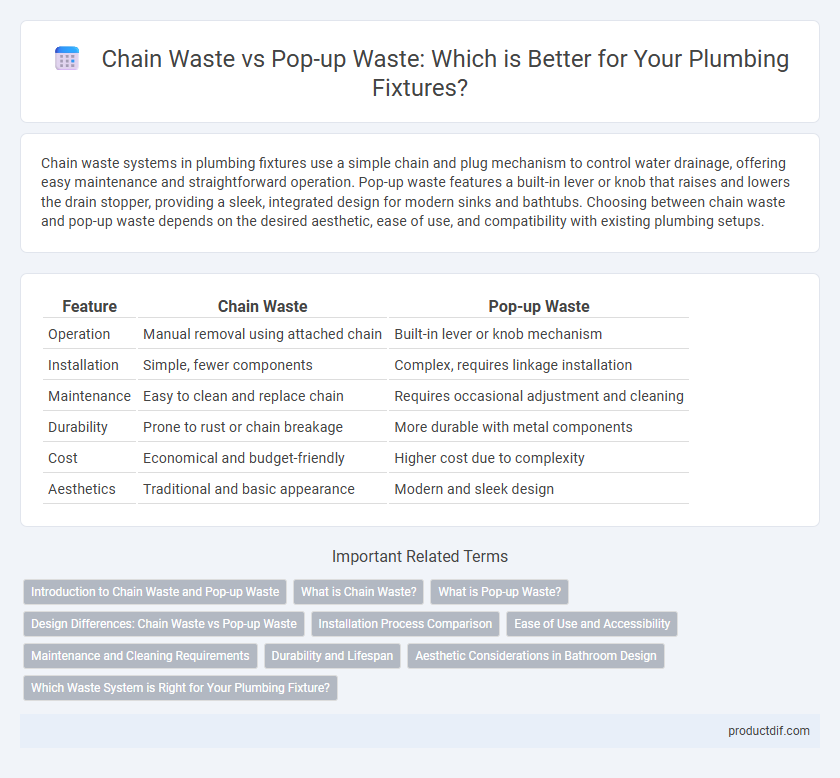Chain waste systems in plumbing fixtures use a simple chain and plug mechanism to control water drainage, offering easy maintenance and straightforward operation. Pop-up waste features a built-in lever or knob that raises and lowers the drain stopper, providing a sleek, integrated design for modern sinks and bathtubs. Choosing between chain waste and pop-up waste depends on the desired aesthetic, ease of use, and compatibility with existing plumbing setups.
Table of Comparison
| Feature | Chain Waste | Pop-up Waste |
|---|---|---|
| Operation | Manual removal using attached chain | Built-in lever or knob mechanism |
| Installation | Simple, fewer components | Complex, requires linkage installation |
| Maintenance | Easy to clean and replace chain | Requires occasional adjustment and cleaning |
| Durability | Prone to rust or chain breakage | More durable with metal components |
| Cost | Economical and budget-friendly | Higher cost due to complexity |
| Aesthetics | Traditional and basic appearance | Modern and sleek design |
Introduction to Chain Waste and Pop-up Waste
Chain waste and pop-up waste are two common types of plumbing fixtures used for sink drainage. Chain waste features a simple plug attached to a chain that is manually lifted or lowered to open or close the drain. Pop-up waste operates through a lever mechanism integrated with the faucet, allowing users to control drainage with ease without touching the plug directly.
What is Chain Waste?
Chain waste is a type of plumbing fixture used in sinks and basins to facilitate water drainage while preventing clogging. It consists of a plug attached to a metal chain, allowing manual removal to retain water or release it as needed. This simple design is favored in traditional or vintage bathroom setups for its ease of use and maintenance.
What is Pop-up Waste?
Pop-up waste is a plumbing fixture mechanism commonly used in sinks and bathtubs that allows water to be retained or drained by lifting or pressing a lever or knob. It features a movable stopper connected to a rod and lever system that opens or closes the drain without the need to manually remove the plug. This type of waste provides convenience and improved hygiene compared to chain waste, as it eliminates the need for a hanging chain and allows for easier operation and cleaning.
Design Differences: Chain Waste vs Pop-up Waste
Chain waste features a traditional design consisting of a plug attached to a metal or plastic chain, which is manually lifted or lowered to control water drainage. Pop-up waste incorporates a lever or push mechanism that raises or lowers the plug internally, offering a sleek, integrated appearance with easier one-handed operation. The design differences affect both the aesthetic appeal and functional convenience in modern bathroom plumbing fixtures.
Installation Process Comparison
Chain waste installation involves attaching a chain to the plug and fitting it through the basin's overflow hole for easy removal, typically requiring minimal tools and straightforward assembly. Pop-up waste systems demand precise alignment of the waste mechanism with the basin's control lever, often necessitating additional components like a lift rod and linkage, making the installation more complex. Both systems require secure sealing to prevent leaks, but pop-up wastes generally involve a more intricate process suited for advanced plumbing setups.
Ease of Use and Accessibility
Chain waste plumbing fixtures offer simple operation by pulling the attached chain to release water, making them highly accessible for individuals with limited dexterity. Pop-up waste systems utilize a lever or button mechanism, providing hands-free convenience that enhances ease of use in modern sinks and bathtubs. Both options cater to different accessibility needs, with chain waste favoring straightforward manual control and pop-up waste emphasizing sleek, ergonomic functionality.
Maintenance and Cleaning Requirements
Chain waste systems require frequent cleaning to prevent blockages caused by debris accumulating in the chain and waste outlet. Pop-up waste mechanisms involve more complex internal parts that need occasional disassembly for thorough maintenance to ensure smooth operation. Regular inspection and timely removal of buildup in both types extend their lifespan and maintain efficient drainage.
Durability and Lifespan
Chain waste systems, typically crafted from stainless steel or brass, offer robust durability and can withstand frequent use, making them ideal for long-term fixtures. Pop-up waste mechanisms, often featuring moving parts like springs and seals, may experience wear and require occasional maintenance, which can shorten their overall lifespan compared to chain waste. Selecting high-quality materials and performing regular upkeep can extend the durability of both chain waste and pop-up waste plumbing fixtures.
Aesthetic Considerations in Bathroom Design
Chain waste fixtures offer a vintage or rustic aesthetic, often complementing traditional or classic bathroom designs with their visible metal chain and plug. Pop-up waste systems provide a sleek, modern appearance by integrating seamlessly with the sink, enhancing minimalist and contemporary bathroom styles. Choosing between chain waste and pop-up waste impacts the overall bathroom design by balancing functionality with the desired visual appeal and style coherence.
Which Waste System is Right for Your Plumbing Fixture?
Choosing between chain waste and pop-up waste depends on your plumbing fixture type and user convenience preferences. Chain waste systems offer simple, manual operation ideal for traditional sinks and bathtubs, while pop-up waste provides streamlined control with a lever or button, suitable for modern bathroom fixtures. Evaluating your fixture's design and maintenance needs can determine which waste system enhances both functionality and aesthetics.
Chain Waste vs Pop-up Waste Infographic

 productdif.com
productdif.com